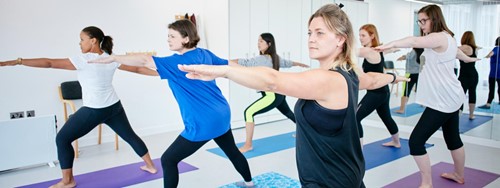Complementary therapies – which ones are right for you?
02 March 2020
Meditative movement is a way of moving or positioning the body in combination with a focus on the breath. Common examples include yoga, tai chi and qui gong, which are all low-impact forms of exercise. It’s thought they may benefit people with conditions such as fibromyalgia, rheumatoid arthritis and osteoarthritis.
Yoga can build muscle strength and endurance, improve body awareness and balance, and increase flexibility and mobility. It can also reduce stress and anxiety through elements of meditation, to promote an improved sense of wellbeing. It’s important that yoga is taught by a qualified teacher, and that you feel comfortable talking to them about your condition and needs.
Easing pain with acupuncture
Acupuncture was developed as part of ancient Chinese medicine and has been shown to have an effect on chronic pain. Applied through the insertion and stimulation of needles at specific points on the body, it is not yet fully understood how acupuncture works.
Acupuncture is available on the NHS for some conditions, ask your GP for more information.
Recommendation is a good way to find a suitable therapist, so ask around – especially if someone has been treated for the same reasons as you. Any good acupuncturist should be able to deal with pain management.
The power of massage
Research shows that massage therapy helps with pain management in the short term, and it can improve mood and health-related quality of life. Any systematic soft-tissue manipulation will enhance muscle relaxation, improve local circulation and boost wellbeing.
Be aware, though, that massage styles differ; Swedish massage, for example, uses oils and classical kneading, rubbing and stroking techniques, while a Thai massage also involves the stimulation of acupressure points, using sustained pressure to the torso.
Certain types of massage are available on the NHS for some conditions, ask your GP for more information.
Talk to your therapist about your condition first, so that your massage can be tailored to you – although a good therapist will know how to work with tender muscles and joints.
“Being mindful means, I am less stressed”
Christine Franklin found that mindfulness has helped her manage pain.
Practising mindfulness can help some people’s arthritis symptom and it’s certainly helped Christine Franklin, 61, who has rheumatoid arthritis.
She has also developed osteoarthritis in her hands and feet. “I was a bit taken aback when the doctor told me I had RA, but I decided to just get on with it. I’m that kind of person. All the medications I tried affected my liver, so I had to stop taking them.
“I’d heard of mindfulness but wasn’t quite sure what it was. Then, two years ago, I won a place on a short course. Since then, I’ve completed a mindfulness diploma.
“Mindfulness is about learning to live in the moment–and it takes a lot of practice. At first, I could only do it for a couple of seconds, but you have to be patient. Thoughts about the past and the future can crowd in.
“We often don’t realise that our minds are constantly chattering, which can be stressful. What will I make for tea? How am I going to manage in 10 years’ time? You have to bring yourself back to the here and now – push negative thoughts away. Stress intensifies pain, but being mindful means, I am less stressed, so the pain is more manageable.”
Take a moment for mindfulness
If you’d like to do a very simple mindfulness-type exercise, try the following:
- Whatever you’re doing, stop for a few minutes.
- Look around and notice five things you can see.
- Listen carefully and notice five things you can hear.
- Focus on sensations on the surface of your body and notice five things you can feel.
You might find you feel more focused and your mind seems less busy after doing this exercise.
We’re here whenever you need us.
- Call our Helpline on 0800 5200 520 (Monday to Friday, 9am to 6pm)
- Talk to our arthritis virtual assistant, 24/7
- Join our online community
- Follow us on Twitter, Facebook and Instagram